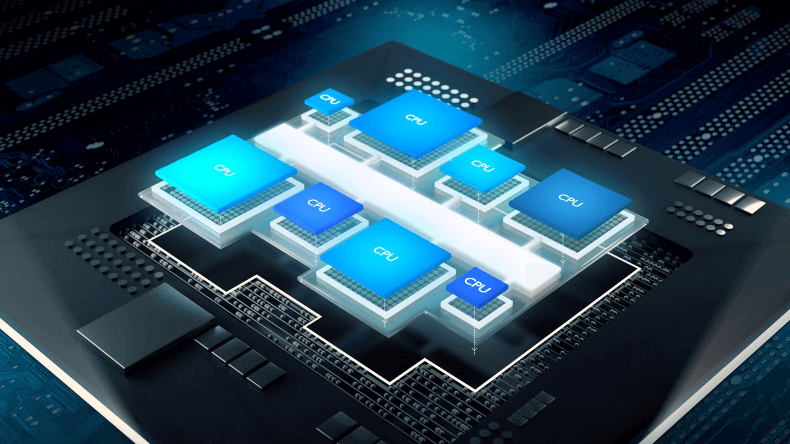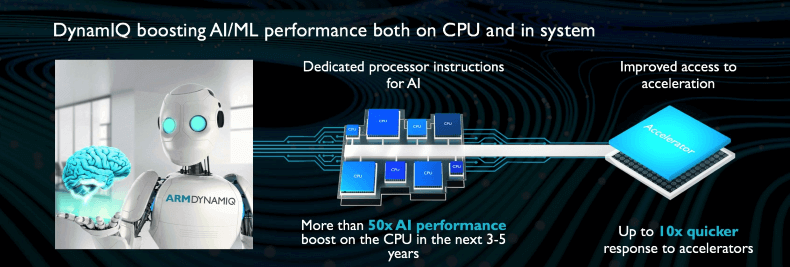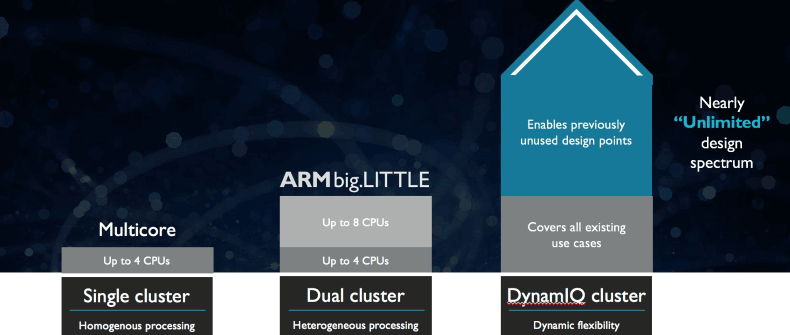Arm DynamIQ: Technology for the next era of compute
Compute solutions are becoming integrated into almost every aspect of our lives from self-driving cars to biometric data collection on our devices, helping us measure our fitness and live healthier lives.

We are in the age of connected intelligence, and it is completely transforming how we live. I see technology making decisions for us regularly and anticipating our next move. Most of the time my devices know what I want even before I know what I want. Compute solutions are becoming integrated into almost every aspect of our lives from self-driving cars to biometric data collection on our devices, helping us measure our fitness and live healthier lives. This unimaginable amount of data is collected to be converted into intelligent decision-making to enrich our lives. It is a new challenge and an opportunity in the compute landscape that is shaping the next wave of innovation.
How will this magical mix of data and compute evolve? We see the demands placed on the compute platform increasing even more, both in absolute performance and in scope of that compute. These future platforms where AI deployment will accelerate everywhere, will not only require more performance than today’s systems, but additional demands for safety – across autonomous platforms such as cars and robots – for increased intelligence in consumer devices and new experiences such as mixed reality.
And while the demand for compute will continue to accelerate, the power and thermal envelopes for all compute systems from the smallest to the largest, will continue to demand hyper-efficient processing – all underpinned by the twin needs of privacy and security – as building trusted, secure solutions is fundamental to all our futures.
Arm currently has a portfolio of CPUs that our partners have deployed to drive the innovation in compute over the last two decades – together we have changed the way the world thinks about compute, a world where over 3.5 billion people rely on Arm-based devices for their primary compute access. However, the challenges we just highlighted give us an opportunity to redefine compute on the CPU again, changing how and where computing happens to meet future market demands. Let me show you how Arm engineers are innovating for the future…
Today’s technology, powering tomorrow’s devices
DynamIQ is a new technology for Arm Cortex-A CPUs that will serve as a foundation for this new era of compute.

- A new single cluster design with up to eight heterogeneous CPUs, allowing for different configurations like 1+7 (i.e. 1xbig and 7xLITTLE CPUs), 2+4, 1+3 to deliver scalable solutions
- Advanced compute capabilities designed specifically to deliver more AI computer performance on the CPU
- Redesigned memory subsystem that is shared across all cores within the cluster for faster responsiveness and efficiency
- Greater flexibility with or without LITTLE configurations to scale into different markets beyond smartphones
- Increased power savings through built-in hardware features for even greater efficiency
DynamIQ fundamentally changes the way compute happens and where it happens to help accelerate AI adoption and transform devices.
What does DynamIQ technology do and how does it address the market challenges described above?
- Faster and more complex data processing for advanced use cases such as AI
- Improved energy-saving through intelligent power features
- Product differentiation and richer user experience (UX) for all markets
Safe, fast and efficient complex data processing for AI

DynamIQ boosts AI computations by up to 50x performance over the next three to five years when compared to previous systems. For additional AI performance, there is improved access to accelerators with a dedicated low-latency port, resulting in up to 10x quicker response. This improved data transfer speed alongside higher data bandwidth, bolsters the overall throughput of a Compute Vision (CV) or ML system.
All in all, these features deliver higher data privacy and security by bringing more compute onto the device. More computing on the CPU means less personal information floating in the cloud, giving you a more secure AI experience.
Additionally, safety-related application performance is improved with shorter latency in decision making and actuation across AI scenarios such as Advanced Driver Assistance Systems (ADAS) for autonomous vehicles. These improvements alongside measures to avoid systematic faults enable high safety integrity to SIL 3 and ASIL D.
Improved energy savings through new intelligent power features
DynamIQ technology improves energy efficiency by incorporating intelligent power features within the cluster that help extract every ounce of performance. This means higher-than-ever data processing and performance, leading to richer experiences – even in smaller devices with constrained thermal budgets.
DynamIQ supports multiple, configurable, performance domains within a single cluster. These domains, consisting of single or multiple Arm CPUs, can scale in performance and power with finer granularity than previous quad-core clusters. This means more fine-tuned ability to stay within the thermal envelope, which results in longer periods of sustained performance. This is especially critical in Virtual Reality (VR) applications, which require sustained performance over longer periods of time, in a thin device with limited battery life and heat thresholds.
DynamIQ technology also introduces a more rapid and autonomous hardware-controlled power state transition mechanism that reduces the latency between the power states supported by Arm Cortex-A CPUs (e.g. ON, OFF and SLEEP). This not only results in shorter durations for powering up a CPU and quicker response times, but also higher energy savings with quicker entry to power-saving states, such as sleep mode and power off.
Autonomous CPU memory power management, a way to intelligently adapt to the amount of local memory available to the CPUs depending on the type of application running, is another key feature in the technology. Applications that demand a high amount of compute performance, such as Augmented Reality (AR), will have the maximum amount of local memory at its dispense, while lighter applications, such as music streaming, will have a scaled-back amount of local memory, saving CPU memory power.
Product differentiation and new performance tiers
DynamIQ technology redefines product differentiation through a wide range of new configuration options, bringing not just increased flexibility and scalability, but ultimately, giving customers the ability to design the right product to meet their requirement, whatever the market.

It is possible with a DynamIQ cluster to build both high performance ‘big’ CPUs and high efficiency ‘LITTLE’ CPUs into a single cluster with a shared coherent memory. In doing so, it not only delivers significant improvements in performance gained from a tighter, more coherent system, but it also presents unprecedented flexibility and choice in CPU cluster design to deliver purpose-built solutions. Another advantage is that each CPU can scale at different frequencies for customized solutions frpm thin devices all the way to servers.
This will especially benefit homogeneous processing systems, such as networking, enabling higher data throughput with eight fully-coherent CPUs in a single cluster. When deployed with Arm CoreLink CMN-600 DynamIQ will scale to high-count multi-cluster systems for infrastructure markets.
What impact will we see as a result of DynamIQ technology?
The features highlighted above will bring change to how and where computing happens, impacting our lives in the following ways. For example:
- Nearly unlimited configurations, presenting new levels of flexibility and scalability for solutions and performance within different tiers; this leads to more options for consumers and device choices that fit their needs
- Built-in power saving features that allow for innovation, from device to the cloud. Thinner devices, longer-lasting battery, energy savings for server farms – power efficiency benefits span across all markets
- Bringing intelligent compute to the devices improves both data security and privacy, as well as faster response times, improving the performance around AI - at home, in the car, or cloud
Arm DynamIQ technology is the new foundation for smarter, faster, and more powerful user experiences for the next generation of intelligent devices. It will fuel innovation in an ever-demanding market for new designs, from thinner devices to cloud-based solutions – wherever computing happens.
Related content
Re-use is only permitted for informational and non-commerical or personal use only.

